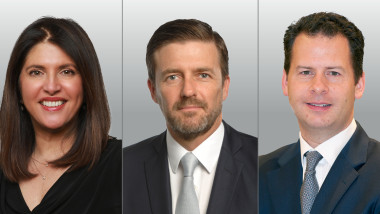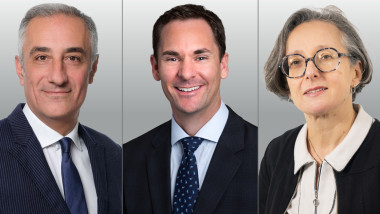2021 Fund Selector Outlook
Fund selectors project a risky 2021 but see opportunity on the horizon
“Unprecedented” may have been the most overused word of 2020, as a global public health crisis, climate events and natural disasters, the fastest market correction in history, and political turmoil all reached extremes that had never been seen. But in the final weeks the global race for Covid immunization provided a glimmer of hope as both Pfizer and Moderna received expedited approval for their vaccines.
The effects of this much-needed shot of optimism came across loud and clear in the results of the 2021 Natixis Global Survey of Fund Selectors. Even as they predict a risky investment environment marked by low to negative interest rates and higher levels of volatility in 2021, these fund selectors representing $12.7 trillion in assets are positioning portfolios to capture the upside potential.
Conducted in November and December 2020, the survey of 400 fund selectors at independent financial advisors, wirehouses, registered investment advisors, insurance company investment platforms, private banks and family offices around the world reveals key trends that are shaping a more optimistic outlook for the year ahead:
- Four in ten project an uptick in market volatility, but in this case they don’t think it’s a bad thing: Allocation plans favor a risk-on approach and two-thirds predict aggressive portfolios will outperform conservative.
- Sector calls project outperformance in healthcare, technology, energy, and consumer discretionary, indicating they see the start of economic recovery on the horizon.
- With yields low, fund selectors’ allocation plans suggest they are willing to trade interest rate risk for credit risk by moving out of government securities and into corporates while they’ll look for additional yield enhancement from private markets.
- To access the opportunities, nearly two-thirds say they will add to their model portfolios offering and enhance their lineup with specialty strategies for ESG (environmental, social & governance) and thematic investing.
At the close of 2020, it appeared that professional buyers believed they were prepared for the risks that would come their way in 2021. Little did they know their mettle might be tested less than a week into the new year with the siege of the US Capitol by Trump supporters.
While the events of January 6 upset the political balance in the United States, they have done little to upset markets or shake investor optimism. In fact, the S&P 500 experienced a net gain of 60 points in the week following the attack. That reaction may be a clear example of just how common “unprecedented” has become.
About the survey
1
A risky world continues to struggle with Covid
Despite the newfound optimism provided by vaccines, six in ten fund selectors believe the Covid new normal is here to stay. This may be significantly better than the 73% of institutional investors who shared the sentiment in November, but professional buyers are still concerned about the pandemic’s economic impact.
Two-thirds of those surveyed predict the global economy will not recover from Covid in 2021. And a majority (60%) say that policy makers in their home country have been ineffective in their response to the pandemic. Only one region bucks the trend as two-thirds of those in Asia believe policy makers were effective, which may be a function of muscle memory built up through managing SARS and swine flu outbreaks over the past 15 years.
In December, it appeared that political uncertainty might ease as the UK moved closer to completing Brexit, but even as the resolution of the four-year ordeal of extricating Britain from the European Union drew nearer to a close, it was counterbalanced by Donald Trump’s refusal to accept the results of the US presidential election.
In the end, while almost six in ten (57%) fund selectors anticipated that geopolitical tensions would deescalate in 2021, their concerns focused on rising social unrest (62%) and democracy weakening across the globe (55%).
But significant concerns about Covid and politics have not necessarily translated into a negative view on markets, as eight in ten believe central bankers will backstop the market in the event of another downturn.
Confident they can handle risky markets
Looking at the investment landscape for 2021, volatility is top of mind for professional buyers in 2021. While they are concerned about an uptick in volatility for both stocks (40%) and bonds (43%), a larger number (53%) foresee higher levels of currency volatility.
Overall, volatility ranks as the top portfolio risk (49%), but concerns run higher in North America, where 65% see it as a portfolio risk, and Latin America where the number is 60%.


Global
(400)
Asia
(43)
EMEA
(146)
Latin America
(15)
North America
(133)
UK
(63)
Volatility
Negative interest rates
Inflation
Credit crunch
Liquidity
Currency fluctuations
Deflation
49%
37%
40%
60%
65%
38%
39%
58%
49%
0%
26%
38%
37%
19%
32%
53%
44%
44%
34%
26%
38%
20%
25%
51%
25%
23%
28%
33%
23%
21%
23%
19%
23%
53%
19%
24%
15%
33%
15%
7%
14%
8%
After a year of dramatic rate cuts and a growing number of central banks moving interest rates into negative territory, negative rates rank second among portfolio risk concerns (39%). The concern is more pressing in Asia, where 58% see it as a risk, and Europe, the Middle East, and Africa region where 49% have risk concerns. In both regions, negative interest rates rank as the top risk concern.
Despite low levels of inflation for most of the past decade, 37% of buyers say they are concerned about the risks it presents to portfolios in 2021. In the US this concern has been borne in the markets, as spreads between two-year and 10-year Treasuries have risen above 100 basis points for the first time since May 2017. Other risk concerns include a credit crunch (34%) and liquidity (25%). And while more than half project higher levels of currency volatility, only 23% see it as a portfolio risk.
Limited correction concerns
Despite the run-up in stocks in the second half of 2020, only one-third of those surveyed (34%) see a correction coming in the next 12 months. The same number suggest a correction may be in the wings for bonds, while only 32% see the white-hot SPACs (Special Purpose Acquisition Companies)1 market heading into correction territory.
Instead they have the strongest convictions about a correction in two places. First, after cryptocurrency reached all-time highs in Q4 2020, 52% of professional buyers believe it is likely to experience a correction in 2021. Second, despite 45% projecting that the technology sector will outperform the broad market, 46% say the sector is likely to experience a correction this year.
Concerns about investor risk appetite
Professional buyers question if individual investors will be able to handle the risks they face in 2021. One notable trend from the pandemic has been an uptick in the number of individuals participating in the market through apps like Robin Hood that allow for low- or no-cost trading. With markets delivering strong performance throughout the pandemic, 80% say retail investors have been taking on risk more carelessly than before Covid-19. As a result, almost eight in ten (78%) worry that the increased volatility will lead individuals to liquidate their investment prematurely.
Projections favor a risk-on strategy
Regardless of where they see the risks, fund selectors are likely to look at it as opportunity. Projections for year-end headlines suggest they will favor a risk-on approach, with 61% calling for small-caps to outperform large-caps, 60% predicting emerging markets to outperform developed markets, and 66% saying aggressive portfolios will outperform defensive in 2021.
Fund selectors indicate that while the opportunities are out there, it will require close analysis to find them: 70% forecast active investment to outperform passive, and 63% project value stocks to outperform growth. And after seeing ESG strategies outperform during the past year, 57% say outperformance will continue in 2021.
Small cap outperforms

Large cap outperforms
Developed markets outperform

Emerging markets outperform
Aggressive portfolios outperform

Defensive portfolios outperform
Passive investing outperforms

Active investing outperforms
ESG funds outperform

ESG funds underperform
Growth stocks outperform

Value stocks outperform
Global economy cannot escape consequences of Covid-19

Global economy fully recovers from Covid-19
Life will revert to how things were before the pandemic

The Covid "new normal" is here to stay
Big tech continues to grow unabated

Big tech is broken up
Geopolitical tensions rise

Geopolitical tensions deescalate
Democracy weakens globally

Democracy strengthens globally
Social unrest deescalates

Social unrest increases
✔ Headline predictions with a point spread greater than 7 points are shown as the prediction
Sector calls: The glimmer of hope sheds light on opportunity
Optimism carries over into sector views, where buoyed by the arrival of multiple vaccines at year-end, pro buyers are particularly bullish on healthcare. Fifty-six percent of those surveyed call for the sector to outperform – a margin of 41% over those who project underperformance.
After another year of unabated growth in tech, many expect the winning streak to continue in 2021. Even with concerns about a potential correction, 45% still call for outperformance from information technology companies.
Fund selectors may not think the economy will recover to pre-pandemic levels this year, but sentiment shows they expect the recovery to begin in earnest with 46% projecting outperformance for consumer discretionary, 44% for energy, 44% for financials and 41% for communication services.
The optimism expressed in their sentiment has been echoed by the broad market in the two months since vaccine day as hopes of a return to normal pushed the energy, financial, materials and consumer discretionary sectors to outperform the S&P 500. Hopes were similarly raised in Europe where energy, materials, and financials each outpaced MSCI Europe.
Since vaccine day (November 9, 2020)
S&P 500 Energy Index
30.9%S&P 500 Financials Index
15.1%S&P 500 Materials Index
9.0%S&P 500 Cons Discret Index
7.3%S&P 500 Index
6.5%S&P 500 Industrials Index
6.1%S&P 500 Health Care Index
5.9%S&P 500 Info Tech Index
5.8%S&P 500 Cons Staples Index
2.0%S&P 500 Comm SVC
1.4%S&P 500 Real Estate Index
0.6%S&P 500 Utilities Index
-2.8%Since vaccine day (November 9, 2020)
MSCI Europe Energy
26.8%MSCI Europe Materials
15.0%MSCI Europe Financials
11.7%MSCI Europe Info. Tech
10.4%MSCI Europe Utilities
8.6%MSCI Europe
7.3%MSCI Europe Comm. Serv.
7.1%MSCI Europe Real Estate
6.1%MSCI Europe Cons. Disc.
6.0%MSCI Europe Industrials
5.7%MSCI Europe Health Care
1.7%MSCI Europe Cons. Stap.
-0.2%One critical conflict in views comes with real estate: While 84% say they will increase or maintain allocations to REITs, they are more likely to see the real estate sector underperforming (38%) vs. outperforming (17%). This sentiment is more likely to show they believe real estate will deliver market average performance (45%), as only 29% anticipate a correction in the sector.
Outperform
Market Average
Underperform
100%
56%
30%
14%
46%
38%
17%
45%
35%
20%
44%
28%
28%
44%
28%
29%
41%
42%
18%
34%
50%
16%
24%
47%
29%
20%
55%
25%
17%
45%
38%
15%
52%
34%
Some data adds up to 101% due to rounding
Covid influencing strategic shifts
Fund selectors are factoring a wide range of risks into 2021 portfolio plans, and return assumptions of 7.1% show some moderation over 2020’s pre-pandemic 7.6%. A majority (55%) do not anticipate making changes to their assumptions in the next 12 months.
In line with that thinking, professional buyers report subtle shifts in allocation strategy for 2021:
- An average increase of 1.4% to equity allocations takes reported stock positions from 44.2% in 2020 to 45.6%, reinforcing their “risk-on” posture.
- Projections for fixed income reveal genuine concerns about negative rates. Buyers anticipate reducing allocations to bonds by 2.4% on average, taking holdings down from 34% for 2020 to 31.6% for the year ahead.
- Allocations to alternative investments appear to be the most likely home for fixed income allocations as professional buyers look for yield replacements. On average, those surveyed anticipate adding 1.3% to this portfolio sleeve, taking it from 14.9% in 2020 to 16.2% in 2021.
2020
2021
When asked why they are implementing these allocation moves, it’s clear that Covid is a critical decision factor, with half (51%) reporting the pandemic as their motivation to rest allocation plans. The likelihood of low to negative yields being in place for a long time weighs heavily in decisions as well, as 48% report making shifts in long-term strategy. In contrast, 38% say their moves are designed to take advantage of short-term opportunities, while one-third see the moves as part of their annual rebalancing.
2
How allocation strategy will play out
Equities
Fixed Income
Alternatives
Cash

Some data adds up to 101% due to rounding
Fixed income: trading rate risk for credit risk
The global pandemic and an ensuing global economic shutdown demanded swift fiscal and monetary action from central banks. After more than a decade of navigating ultra-low interest rates brought on by the Global Financial Crisis, investors had already been taxed to find yield opportunities; now the job is that much harder.
The end result of central banks’ action included 200+ rate cuts worldwide, with many countries heading into negative territory. By July more than one-quarter of the Bloomberg Barclays Global Aggregate Index was trading with negative yields and more than $18 trillion in negative yielding debt globally.2
Negative rates factor heavily into the equation for professional buyers, as 30% say their organization has already invested in negative yielding securities and almost half (49%) also expect to see more negative yielding bonds in the future.
As a result, 44% of professional buyers who already hold government securities say they will trim their holdings while only 40% plan to maintain current positions. To get the yield they need, they are most willing to trade interest rate risk for credit risk and increase or maintain investments in the riskier end of the fixed income spectrum including emerging market3 where 87% will increase or maintain holdings. Securitized debt4 (78%), high yield corporates5 (78%) and investment grade corporates6 (77%) also take a prominent role in portfolio plans.
One standout move shows that ESG is taking hold in fixed income plans as pro buyers anticipate adding more green bond7 strategies to investment platforms. Among the 53% surveyed (210) who already invest in the asset class, 94% said they will look to increase or maintain their investments in 2021.
Equities: risk-on around the world
In a remarkable sequence of 2020 events, equity markets experienced record losses and gains. The S&P 500 experienced its fastest downturn on record and followed it with the fastest recovery ever. After dropping 34% in March, the index came roaring back to regain those losses by June and ultimately rang up an 18.4% gain for the year.8
With more fiscal and monetary stimulus likely to come from policy makers, fund selectors think stocks have even more room to run in 2021 and they will look around the globe for opportunities.
Just over one-third (36%) plan to decrease US equity holdings. This may be less about market concerns and more about taking gains to capitalize on market performance in other regions, as another third (32%) will increase their US holdings. The remaining third (32%) will maintain their positions.
In seeking out these new opportunities, more than half (55%) say they will add to APAC stocks. Swift and dramatic responses to the pandemic may help fuel optimism for the region after China’s Shanghai Composite posted a 13.87% gain and Taiwan’s Taiex delivered a 22.8% return.
Beyond Asia, fund selectors appear ready to scour the globe for opportunity, as 52% also say they will add to emerging market positions. Interest in these stocks may be significant at this point in time, as 65% say emerging markets look more attractive now than before Covid. Many will watch macro trends in these regions more closely, as 79% say they will play a more important role in emerging markets than they did before the pandemic.
Alternatives: replacing traditional income sources
Alternative investments look to play a critical role in the quest for yield. With central banks cutting rates and keeping them low in order to guide the economy through the pandemic, professional buyers know they need to look beyond bonds. Plans for alternative allocations focus largely on assets with the potential to make up the difference.
Private equity, infrastructure, private debt9 and real estate all look to reap increased investment from institutions in 2021. Among those who already hold the asset classes in their portfolios, 93% intend to increase or maintain their holdings in private equity, the same number plan to do the same with infrastructure, and 94% plan to do the same with private debt.
So, while they appear willing to take on additional credit risk, institutions may see even greater benefit in taking on the liquidity risk that comes with private investments. In truth, 54% say they are concerned with liquidity risk in private assets,10 but their actions show that given the likelihood that a low to negative interest rate environment is likely to last a good while longer, they like the surety that comes with the lock-up.
In essence, allocating more to private assets may be seen as the opportunity to enhance performance with less risk of the big drawdowns seen in public markets. And that looks to be the focus of their tactical plan for 2021.
3
Managing the business
Along with the challenges of navigating a potentially riskier market in 2021, fund selectors see their firms transforming the investment offering to achieve greater consistency across client portfolios and better meet client needs. In rationalizing their product offering, 80% of buyers say the emphasis is on quality rather than quantity.
One key area of focus is ESG, where 77% of those with strategies on platforms say they will add to their offering. Six in ten (59%) also say they will increase the number of active funds they offer, while another 50% will add to private equity. In North America, 47% of buyers say their firms will add to their separately managed account platforms as well.
(% of fund selectors)
Firms focus on models to provide a consistent experience for clients
Given the focus on riskier, more volatile assets and concerns about potential liquidations, it stands to reason that among the 295 professional buyers whose firms offer clients model portfolios, more than half (54%) anticipate that they will move more clients to model portfolios in 2021.
When asked about the benefits of model portfolios, the majority (55%) say models provide clients with a more consistent investment experience. With many firms looking to help clients consolidate holdings, another 41% say models provide a more efficient way to implement unified managed accounts for clients. Another 36% say models provide a greater opportunity to tailor portfolios to client needs. Three-quarters say model portfolios also provide an added layer of due diligence in investment selection.
The growing demand for
Half of fund selectors say they'll move existing client assets into models
30% will add third party models to platform within next 12 months
Efficiency and consistency are key factors in the move to models
77% say models offer an added layer of due diligence in investment selection
Key benefits and challenges of model portfolios
Benefits
- 55% More consistent client experience 91% Registered Investment Advisors 72% Insurance Platform Managers
- 41% More efficient implementation of UMA* 89% for Defined Contribution Platform Managers
- 36% Greater ability to tailor to client needs
- 33% Managing firm's risk exposure
- 31% Lower cost option
- 30% More time for advisors to address client needs92% for Wirehouses
Challenges
- 41% Providing some level of customization
- 36% Evaluating when to offer new models and rationalize offering
- 30% Offering models that mitigate risk
- 28% Analyzing performance results
- 24% Convincing advisors to adopt models
*Unified Managed Accounts
A majority of fund selectors see a greater need for specialty models

61% say they’re adding ESG because of client demand
66% say models make it easier to implement ESG across client portfolios
As they look to enhance their offerings, 64% say their firm is finding a greater need for specialty models such as ESG or alternative investments. ESG stands out as an area where firms are looking to enhance their model programs, with 64% saying they will deploy new models in the next 12 to 24 months. One key reason for the focus: 66% believe models make it easier to implement ESG across client portfolios.
Other areas where they will look to expand include thematic investments (50%), alternative investments (29%) and tax-managed strategies (23%).
Plans call for adding active strategies
Given that fund selectors see the potential for greater volatility and are projecting value stocks to outperform growth stocks, it’s not surprising to see that 83% believe markets will favor active investments in 2021. Their commitment to active was likely reinforced last year, when two-thirds say active investments on their firm’s platform outperformed during the market downturn.
The positive view on active investments extends well beyond 2021. Today, professional buyers report that on average, 72% of assets are invested with active managers, while only 28% are in passive investments. Little change is expected over the next three years, as they project allocations will be 70% to active and 30% to passive.
Active/Passive Allocations and Projections
2020 allocation
2023 projection
Active Investments
72%
Active Investments

70%
Active Investments
Passive Investments
28%
Passive Investments

30%
Passive Investments
On the flip side of the coin, professional buyers see a significant downside to the popularity of passive investments. Three-quarters say large flows into and out of passive investments actually exacerbate volatility, and 65% believe the widespread use of passive investments shows the market is ignoring the fundamentals.
Pursuing private options
Private assets will continue to be a focus for professional buyers in 2021 and beyond. Given that rates were low before 2020 and are now even lower, it’s no wonder that 53% say private assets will play a more important role in portfolio strategy. But they go into private markets with eyes wide open.
Given the shift to private assets among both institutions and the wholesale platforms they themselves manage, professional buyers worry that there is too much money chasing too few deals. Another 54% worry about liquidity risk, while 36% are concerned about the increasing complexity presented in private asset investments.
Despite any concerns, professional buyers also see an important advantage to investing in private assets in today’s markets: One-third (34%) say private assets could provide a safe haven in the event of a correction, as was tested by the record downturn at the start of 2020. Six in ten say the resiliency demonstrated by private assets during Covid will increase demand.
Setting a new precedent
Professional buyers clearly see challenges in store in 2021 as the global economy struggles to recover from Covid. But even as they see the potential for risk and volatility, they are also looking at opportunity. As a result they continue to adjust both their allocation strategy and product offering to better adapt to the pandemic market and new client needs. In the end, they are taking on these “unprecedented” times with a clear, measured plan that will lay the groundwork for years to come.
READ THE EXECUTIVE OVERVIEW
The 2021 Fund Selector Outlook Executive Overview provides a summary of the report as well as the report graphics.
Download Executive Overview
2 Source: Natixis PRCG
3 Emerging markets refers to financial markets of developing countries that are usually small and have short operating histories. Emerging market securities may be subject to greater political, economic, environmental, credit and information risks than US or other developed market securities.
4 Securitized debt instruments are financial securities that are created by securitizing individual loans (debt). Securitization is a financial process that involves issuing securities that are backed by a number of assets, most commonly debt.
5 High yield bonds are rated below BBB/Baa. Ratings are determined by third-party rating agencies such as Standard & Poor's or Moody's and are an indication of a bond's credit quality.
6 Investment grade refers to bonds rated BBB/Baa or higher. Ratings are determined by third-party rating agencies such as Standard & Poor's or Moody's and are an indication of a bond's credit quality.
7 A green bond is a type of fixed income instrument that is specifically earmarked to raise money for climate and environmental projects.
8 Source: Bloomberg
9 Private debt includes any debt held by or extended to privately held companies.
10 Private assets are those assets not publicly traded and are generally owned directly by the family or closely-held institution through a partnership(s).
The data shown represents the opinion of those surveyed, and may change based on market and other conditions. It should not be construed as investment advice.
This material is provided for informational purposes only and should not be construed as investment advice. The views and opinions expressed are as of February 1, 2021 and may change based on market and other conditions. There can be no assurance that developments will transpire as forecasted, and actual results may vary.
All investing involves risk, including the risk of loss. No investment strategy or risk management technique can guarantee return or eliminate risk in all market environments. Investment risk exists with equity, fixed income, and alternative investments. There is no assurance that any investment will meet its performance objectives or that losses will be avoided.
Unlike passive investments, there are no indexes that an active investment attempts to track or replicate. Thus, the ability of an active investment to achieve its objectives will depend on the effectiveness of the investment manager.
Absolute return strategies are not intended to outperform stocks and bonds during strong market rallies, and may underperform during periods of strong market performance.
Asset allocation strategies do not guarantee a profit or protect against a loss.
Alternative investments involve unique risks that may be different from those associated with traditional investments, including illiquidity and the potential for amplified losses or gains. Investors should fully understand the risks associated with any investment prior to investing.
Below investment grade (high yield) fixed income securities may be subject to greater risks (including the risk of default) than other fixed income securities.
Commodity-related investments, including derivatives, may be affected by a number of factors including commodity prices, world events, import controls, and economic conditions and therefore may involve substantial risk of loss.
Fixed income securities may carry one or more of the following risks: credit, interest rate (as interest rates rise bond prices usually fall), inflation and liquidity.
Real estate investing may be subject to risks including but not limited to declines in the value of real estate, risks related to general economic conditions, changes in the value of the underlying property owned by the trust, and defaults by borrowers.
Real estate investing may be subject to risks including but not limited to declines in the value of real estate, risks related to general economic conditions, changes in the value of the underlying property owned by the trust, and defaults by borrowers.
Sustainable investing focuses on investments in companies that relate to certain sustainable development themes and demonstrate adherence to environmental, social and governance (ESG) practices; therefore the universe of investments may be limited and investors may not be able to take advantage of the same opportunities or market trends as investors that do not use such criteria. This could have a negative impact on an investor's overall performance depending on whether such investments are in or out of favor.
Value investing carries the risk that a security can continue to be undervalued by the market for long periods of time.
An index fund is a type of mutual fund with a portfolio constructed to match or track the components of a financial market index.
S&P 500® Index is a widely recognized measure of US stock market performance. It is an unmanaged index of 500 common stocks chosen for market size, liquidity, and industry group representation, among other factors. It also measures the performance of the large-cap segment of the US equities market.
Bloomberg Barclays Global Aggregate Index is a market-weighted index of global government, government-related agencies, corporate and securitized fixed income investments.
The MSCI Europe Index captures large and mid-cap representation across 15 Developed Markets (DM) countries in Europe. With 437 constituents, the index covers approximately 85% of the free float-adjusted market capitalization across the European Developed Markets equity universe.
You cannot invest directly in an index. Indexes are not investments, do not incur fees and expenses and are not professionally managed.
Diversification does not guarantee a profit or protect against a loss.
Volatility management techniques may result in periods of loss and underperformance, may limit the Fund’s ability to participate in rising markets and may increase transaction costs.
This document may contain references to copyrights, indexes and trademarks that may not be registered in all jurisdictions. Third party registrations are the property of their respective owners and are not affiliated with Natixis Investment Managers or any of its related or affiliated companies (collectively “Natixis”). Such third party owners do not sponsor, endorse or participate in the provision of any Natixis services, funds or other financial products.
The index information contained herein is derived from third parties and is provided on an “as is” basis. The user of this information assumes the entire risk of use of this information. Each of the third party entities involved in compiling, computing or creating index information disclaims all warranties (including, without limitation, any warranties of originality, accuracy, completeness, timeliness, non-infringement, merchantability and fitness for a particular purpose) with respect to such information.
Natixis Distribution, L.P. is a limited purpose broker-dealer and the distributor of various registered investment companies for which advisory services are provided by affiliates of Natixis Investment Managers.
3425066.1.2






 Private assets: Is regulation a brake or an accelerator?
Private assets: Is regulation a brake or an accelerator?
 All back to bonds?
All back to bonds?
 Why Everyone’s Talking About… Market Bubbles
Why Everyone’s Talking About… Market Bubbles
 Equities: How worried should we be about valuations?
Equities: How worried should we be about valuations?